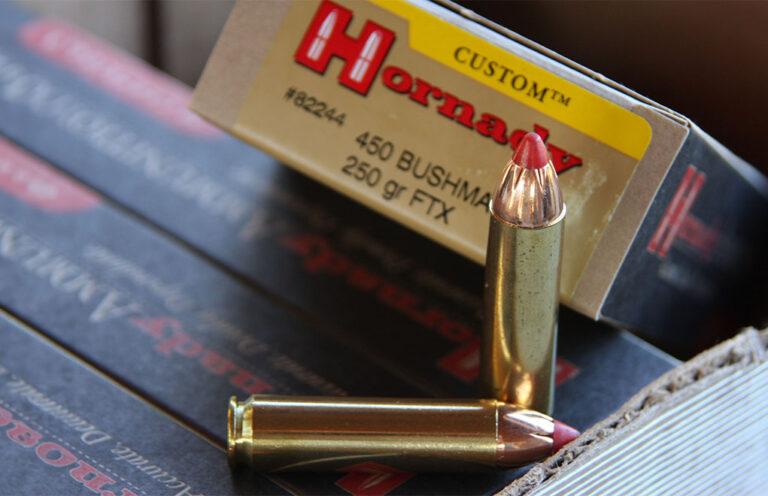
When too much still isn’t enough, it may be time to consider a big-bore AR-15.
Just what is a big-bore AR-15?
Before we can determine that we must clearly define our task. To me, it first means it’s the AR-15 not the AR-10 or other amalgams, derivatives or evolutions. So, despite our esteemed editor’s suggestion, a rifle in .308 is not a big-bore AR-15.
The second variable one might think of would be that any cartridge hurling a bullet larger in diameter than 0.224 inch is a “big-bore” AR-15. I’m not buying that, either. Oh, I’ve bought such rifles, but I don’t consider a 6mm ARC, 6.5 Grendel or a .300 Blackout to be “big-bore” in an AR-15 … or any other rifle for that matter.
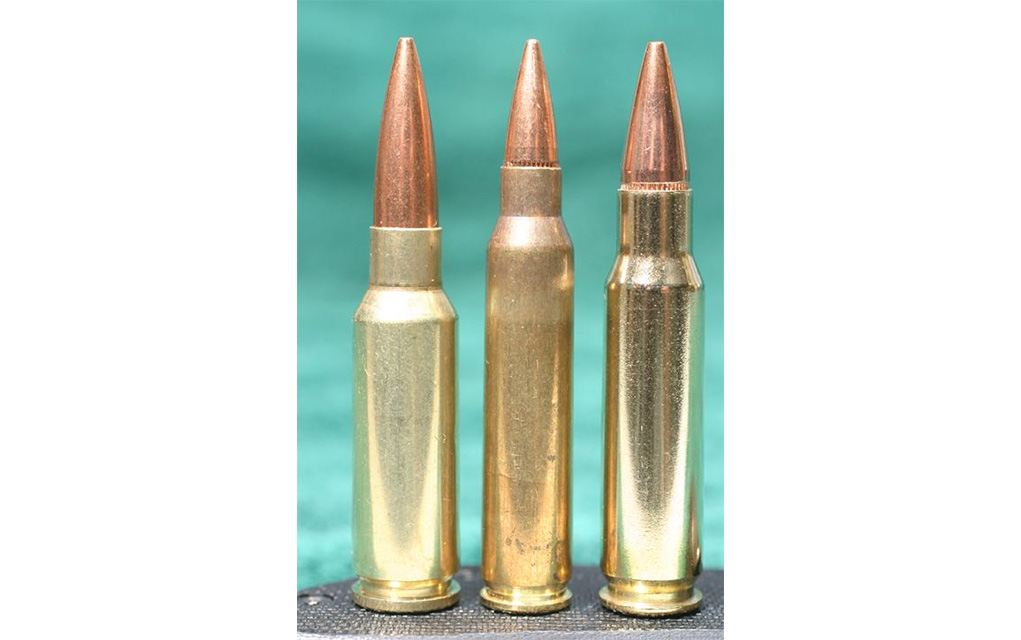
No, for me, a big-bore AR-15 has to be pushing a bullet more than 0.308 inch in diameter. So, what are the choices these days?
.350 Legend
I’ve got one, and I am fond of it. For those who hunt where a bottlenecked cartridge is prohibited, it’s the next best thing to sliced bread or an already-dressed whitetail. It’s a Winchester cartridge, and it fires 0.357-inch bullets of 160 to 180 grains in weight. “Oh, a .350 Remington,” you’re thinking. Well, yes, but no one has ever complained about the effectiveness of the .350 Rem. on deer. In testing, I shot some Hornady American Whitetail 170-grain interlocks into clear ballistic gel and got 26 inches of penetration and a fully expanded bullet. Sounds like venison time to me.
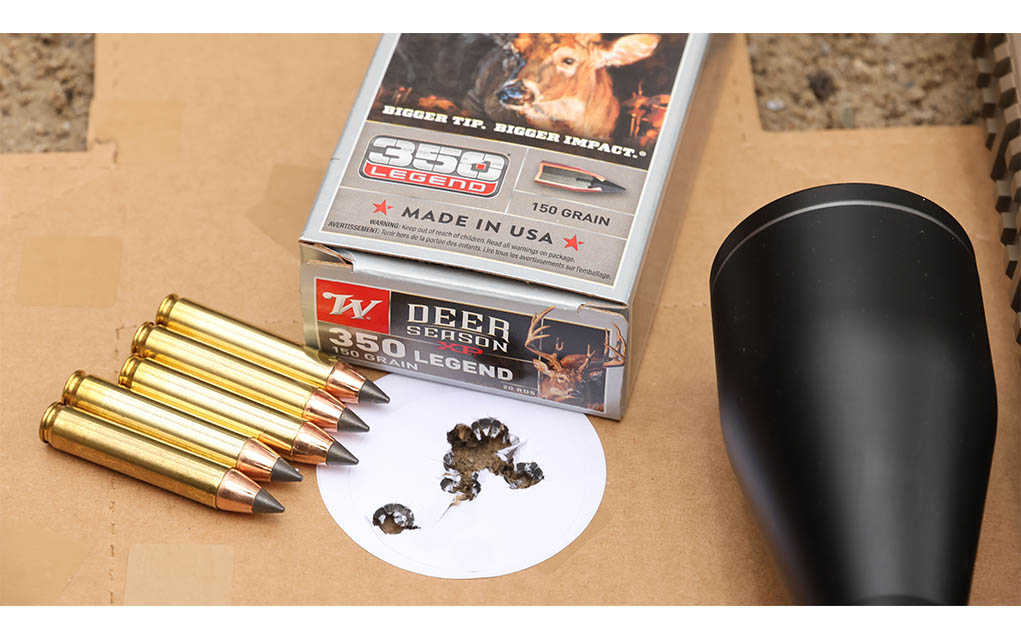
The .350 case has the same rim diameter as that of the .223/5.56, so you can get an AR rebuilt to it by a simple-enough barrel swap, pulling out the worn .223/5.56 barrel and installing one in .350 Legend. Yours might be magazine-picky, and it might not—there’s an easy way to find out. The .350 is the smallest of the big-bore ARs, but it’s plenty enough for hunting, and as a bonus you could even use it in self-defense if you had to.

.400 Legend
OK, you’re Winchester, and now that you’ve updated the .350 Rem to the 21st century, what’s next? Well, how about the .400 Legend? Winchester designed an entirely new case for this one, and on the front end, it uses bullets of 0.400 inch in diameter. As a straight-walled case, that means it doesn’t need a rebated rim, and the rim is 0.422 inch in diameter, the same as the 6.8 Remington SPC.
What this means, with a 215-grain bullet going a nominal 2,250 fps, is that the .400 Legend has less recoil than the .450 Bushmaster (but more than the .350 Legend, obviously) while delivering almost the same energy at 100 yards that the .450 does, and with less drop. As a big bonus for those considering a step up from using a shotgun with slugs, the .400 has half the recoil but twice the energy at 100 yards that a 1-ounce slug generates. I’ve fired enough slugs in my life that that alone makes the .400 very attractive.
So far, it’s loaded only with a 215-grain Power-Point bullet, but any jacketed bullet of 0.400-inch diameter will work for reloading. You’ll have to show some restraint, as your typical bullet made for the .40 S&W or 10mm pistol cartridge will not be as stoutly made as the 215 Power-Point, and shouldn’t be used for hunting—period, end of story. But if you want to load up some low-recoil practice/training ammunition using those bullets, the future looks rosy. Just be sure and use jacketed; the all-lead and the coated ones will be murder on your gas system.
.450 Bushmaster
The Bushmaster uses pistol-diameter .45 bullets, so jacketed .451-inch bullets are what you need to stock up on if you plan to reload your empties. The case calls for bullets heavier than those you’ll find for the .45 ACP, but the 450 has been out long enough (it was new in 2007) that you’ll have plenty of choices. The case was derived from the .284 Winchester and uses a rebated rim to fit into an AR bolt face, with a rim of 0.477 inch in diameter. Specifically, the diameter used for the 7.62×39 or 6.5 Grendel cases.
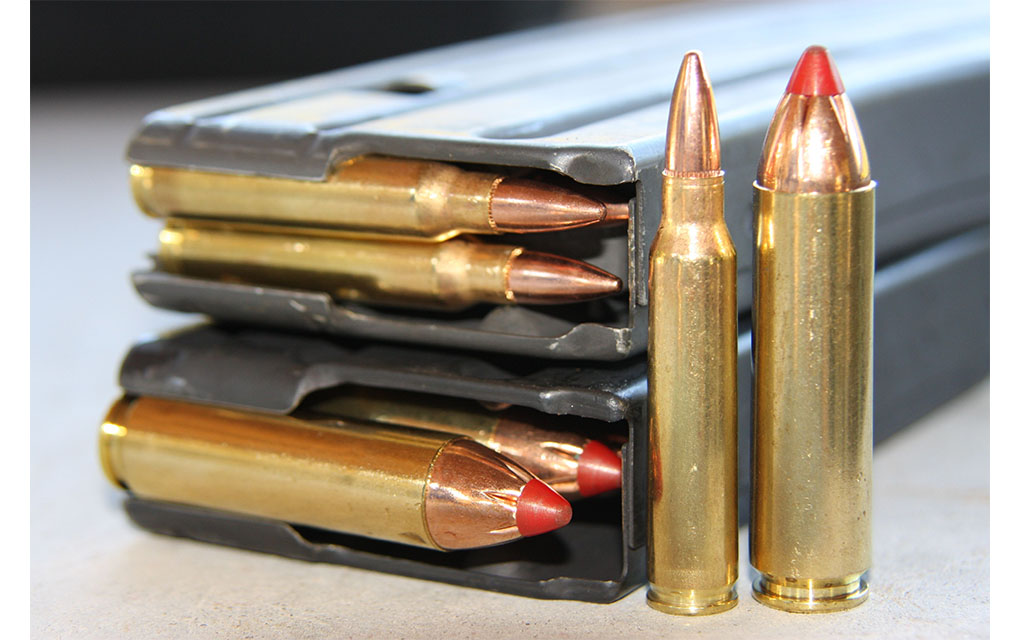
The .450 Bushmaster is plenty robust, hurling 250-grain Hornady FTX bullets (with a soft polymer tip) at 2,100 fps out of a carbine-sized AR-15. You’ll feel the recoil.
The .450 Bushmaster has the energy required by the DNR in states that permit straight-walled cartridges for hunting, but you’ll have to eat your Wheaties, as the recoil from a typical AR-15 (let’s say, under 8 pounds) is going to be stout. This made it not so attractive to new hunters, and those of small stature, which is how Winchester came to develop the .350 and then the .400 Legend.
.458 SOCOM
The SOCOM, as its name might give you a hint, was developed for use by the bearded gents who track down bad guys and deal with them in faraway places. They wanted something with more horsepower than the 5.56, and boy did they get what they wanted. The SOCOM uses rifle-diameter bullets, so you will be looking at relatively “lightweight” bullets starting at 300 grains and going on up.
The case is a lengthened .50 AE, necked down to hold 0.458-inch bullets, and it also has a rebated rim, as there is only so much space on an AR-15 bolt for a case rim. The .458 SOCOM rim is 0.473 inch in diameter, which is the absolute limit of what an AR-15 bolt can take.
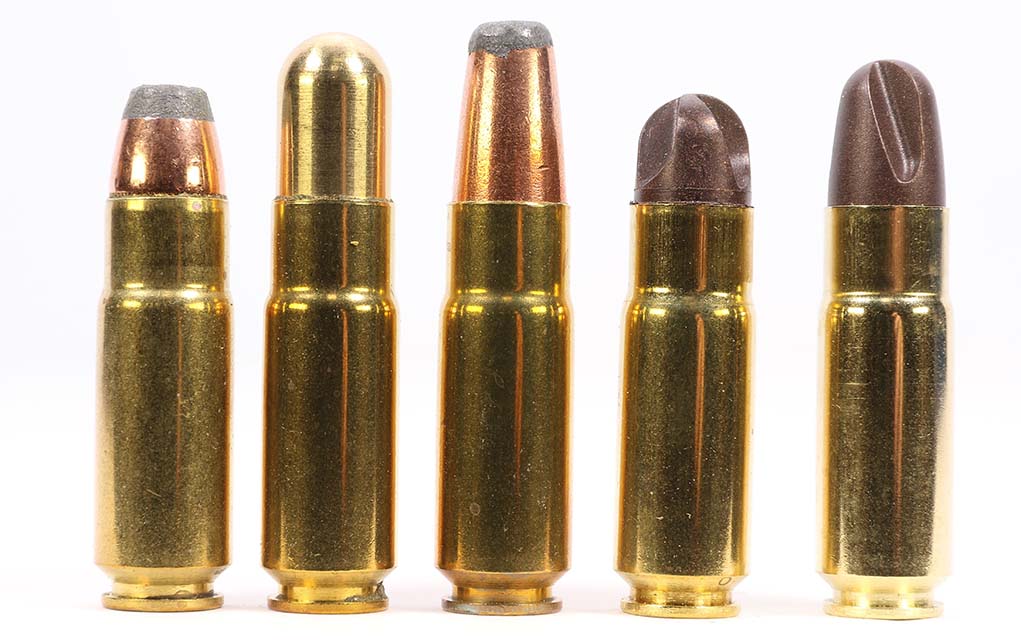
In the 300-grain hunting load offerings, you’ll see velocities from 1,850 to just shy of 1,900 fps. If you are looking for lighter-weight bullets, the Inceptor 140-grain can be pushed up to 2,450 fps. If you prefer heavier bullets, then you can find offerings in the 400 to 500 and even up to 600 grains, and the latter ones can be had in subsonic loadings. A quiet sledgehammer, anyone?
The .458 SOCOM in those loads is essentially a 12-gauge slug equivalent, but with better bullets and out of an AR-15. One detail you’ll have to look out for is ejection. The .458 SOCOM tests the limits of the ejection port opening, and you may find ejection a bit laggard if you have built yours on a vanilla-plain upper. When I built mine, I used a flat-sided billet upper, and simply milled the ejection port larger so as to accommodate the cases. I didn’t bother with an ejection port cover door; I’m not going to be using a .458 SOCOM like I’d use a combat AR-15.
.458 Ham’r
I am fond of the .458 Ham’r, designed by Bill Wilson, but it falls outside of our definition. The Ham’r runs at higher pressures than those of the SOCOM, and as a result, it has to have an AR-10 sized bolt. That makes it a Chimera, an AR-15 lower with an AR-10-dimensioned upper, in order to take the pressures. I love it; it fires a 300-grain bullet at 2,100 fps, but it isn’t an AR-15 as we defined things here.
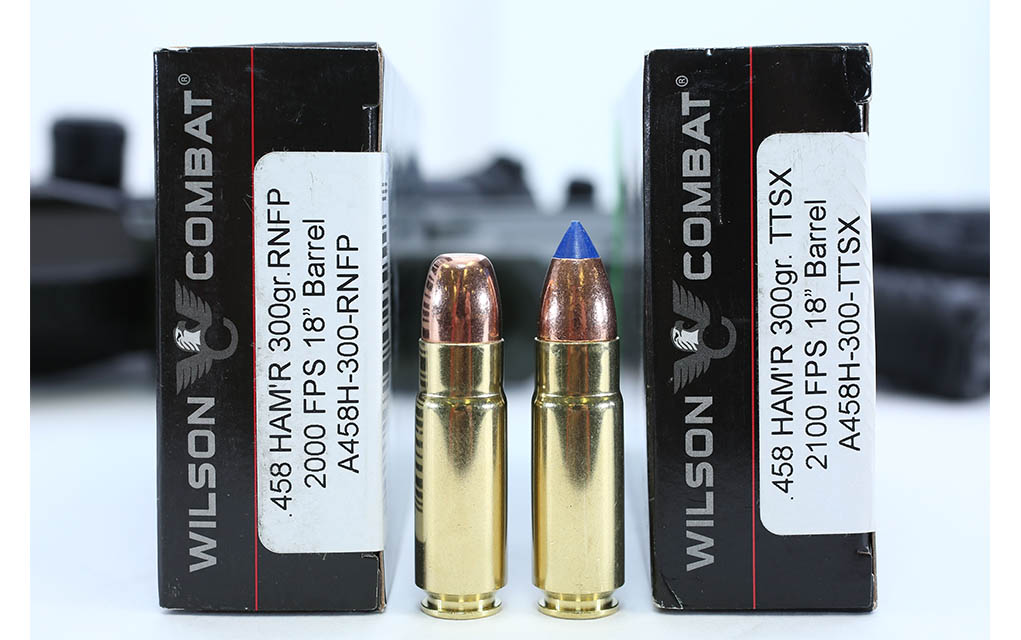
.50 Beowulf
Designed by Bill Alexander, the Beowulf is one of the first big-bore AR-15 cartridges. Coming out in 2001, it’s a rebated-rim straight-walled case holding bullets of 0.500 inch in diameter. The case is a stretched .50AE, with the overall length of the loaded cartridge just enough to fit into an AR magazine and still feed properly. It, like the .45s, feeds single-stack out of the magazine.
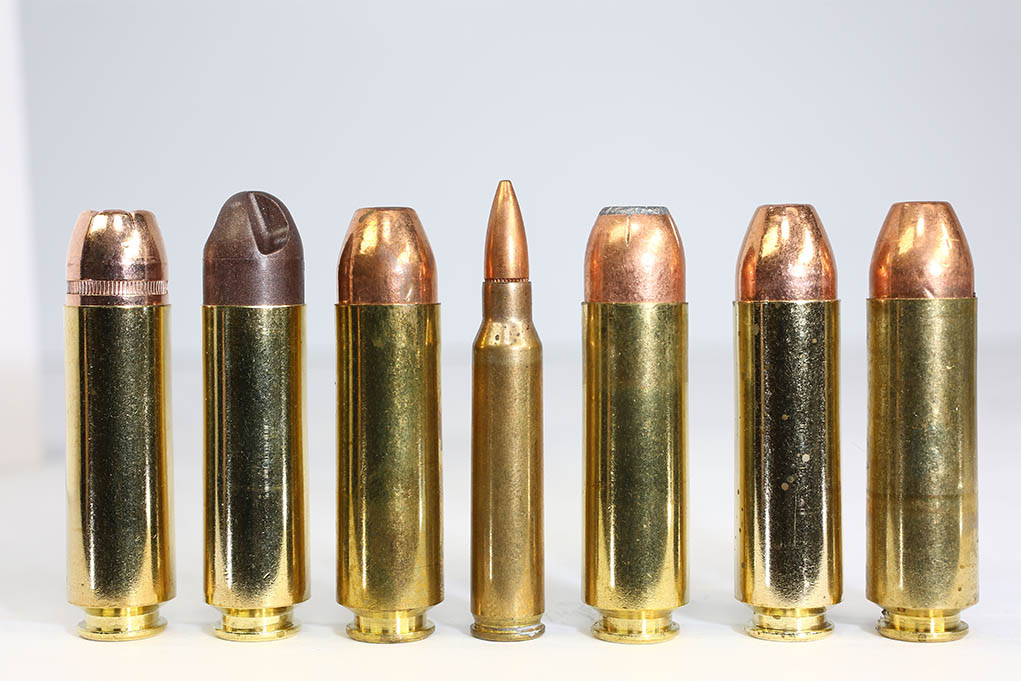
The 300-grain bullet loads run just under 1,900 fps and heavier 325- to 335-grain loads run from just under 1,800 fps to almost 1,900 fps. The Beowulf is a proprietary cartridge, so it is not SAAMI-approved, and thus not loaded by other ammunition makes. Ammunition comes solely from Alexander Arms, but they have plenty, and loaded with bullets from 200 to 400 grains in weight.
The .50 Beowulf I tested came with their “Tank” brake, and I was glad of it. Firing 12-gauge slug recoil-equivalent ammunition from a rifle that full-up tipped the scales at 8 pounds would be … interesting, were it not for the brake.
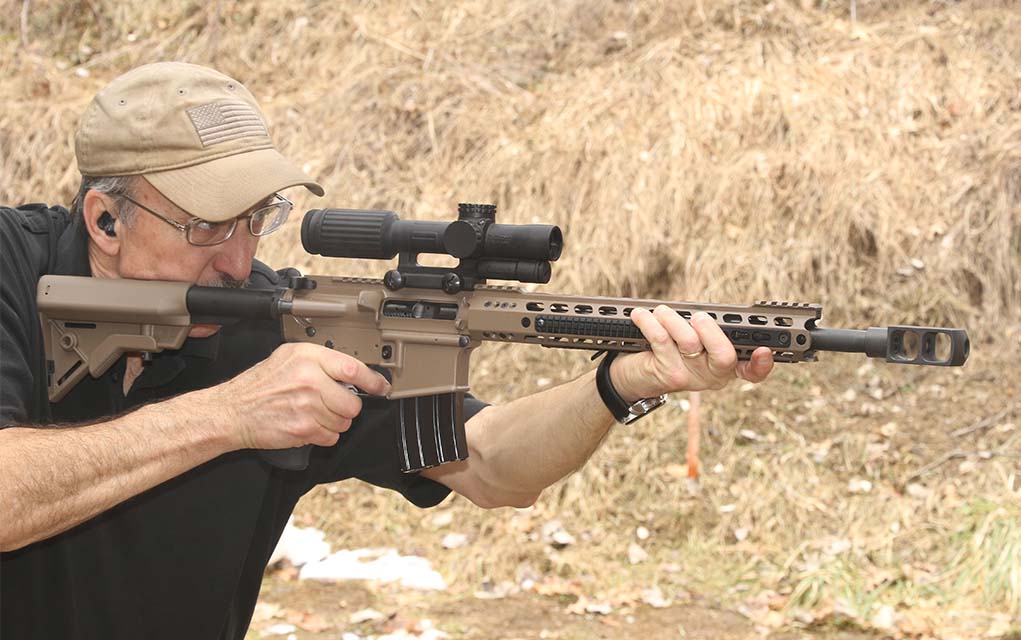
The Little Things Matter, Too
All of the big-bores are accurate. When I was testing the Beowulf, I found that it hit so hard on the other end and hit so precisely to where I was aiming, that what I was plinking at simply disappeared when the bullet got there. They’re probably all more accurate than 99 percent of the shooters using them, so there’s no concern in that point. And if you reload, then the world will be your oyster.
With the exception of the .458 SOCOM, they are all straight-walled cases, and as a result, they will be relatively easy to resize. No need to worry about bumping back the shoulder just enough, and if you do not invest in carbide sizing dies (I heartily recommend that you spring for the extra few dollars it takes) then a little lube, cleaned off after resizing, will go a long way.
While the .400 Legend is really new, and thus bullets for it might be a bit tough to source, the others are in common diameters, and bullets for them have been being made for years, if not decades. And there’s also the economy.

The .350 legend, for example, uses much the same weights in powder as does the .223/5.56 (although not the same powders, just to be clear) which is half that of what a .308 load requires. Yes, the .308 generates more velocity and thus more energy, but how much do you need for a whitetail? For a 180-grain bullet, 25 grains of powder gets you 2,200 fps in a .350, while it takes 39 to generate 2,375 fps in the .308. Do you think the whitetail would notice the difference? Perhaps not, but your shoulder and wallet will.
The best part? You can build or buy a new AR to handle these cartridges, or you can just invest in an upper and some magazines. The uppers of the big-bores will have been tuned to operate on regular AR-15 lowers, so if you buy an upper in .350 Legend, you can have range time with the .223/5.56 upper you usually park there, and then once you’re zeroed, go off and hunt with the Legend. The buckets of practice ammo you’ve burned in .223 will carry over to using the .350 Legend (or the others) and you will be a better shooter for that.
For hunters in the Midwest who have to deal with DNR straight-wall-case regulations, there are a lot more choices now than there had been just a few years ago. And for those looking for a new challenge, or a different range experience, big-bores can be a lot of fun.
Editor's Note: This article originally appeared in the May 2024 issue of Gun Digest the Magazine.
Get On Target With More AR-15 Knowledge
- Top AR-15 Rifles – Options For Any Budget
- AR-10 vs AR-15 Comparison – How Stoner’s Rifles Stack Up
- Top AR-15 Upgrades – The Best Parts & Accessories
- How To Install AR-15 Lower Parts
- How an AR-15 Upper Works
- Buyer's Guide: Best AR Pistol Brace
- AR Pistol Buyers Guide – Best Options for Any Budget
- What Caliber is Best for AR-15

Next Step: Get your FREE Printable Target Pack
Enhance your shooting precision with our 62 MOA Targets, perfect for rifles and handguns. Crafted in collaboration with Storm Tactical for accuracy and versatility.
Subscribe to the Gun Digest email newsletter and get your downloadable target pack sent straight to your inbox. Stay updated with the latest firearms info in the industry.

![Best Concealed Carry Guns In 2025 [Field Tested] Wilson Combat EDC X9S 1](https://gundigest.com/wp-content/uploads/Wilson-Combat-EDC-X9S-1-324x160.jpg)


![Best 9mm Carbine: Affordable PCCs [Tested] Ruger Carbine Shooting](https://gundigest.com/wp-content/uploads/Ruger-Carbine-Shooting-100x70.jpg)
![Best AR-15: Top Options Available Today [Field Tested] Harrington and Richardson PSA XM177E2 feature](https://gundigest.com/wp-content/uploads/Harrington-and-Richardson-PSA-XM177E2-feature-100x70.jpg)

erik not sure but but the biggest advance in ammunition have come in the form of better powders. This being the case if the .400 is rated or only factory loaded with better burning powder or I’ve seen times when one case is just more efficient with powder you give it too. You wouldn’t think the tiny 6mm arc could keep pace with .243 win. If factory loaded as high as they could go the .243 winchester can make you think twice. Highest grain bullets on handloaders books is 120gr dtac but I’ve never seen a hunting version of that if I can even find anything close to that in the factory. I know I’m not giving a good explantion but it has to something like that. Factory loading one must remember only cover what’s popular not necessarily everything the gun is indeed capable of. Also when when the first cartridge came out the powders that might change the equation might not have been available. So yeah it’s confusing but certainly possible. Mind you also subject to change. since the bushmaster I know is the older cartridge the powder thing is very likely the culprit. It’ll take them a bit but load a better power density powder and what bushmaster make you flinch.
The article says the 400 Legend is equal in power to the 450 Bushmaster. The Bushmaster case has a 22% greater capacity and shoots a heavier bullet. Hard for me to see that their downrange performance could be equal. Please explain.